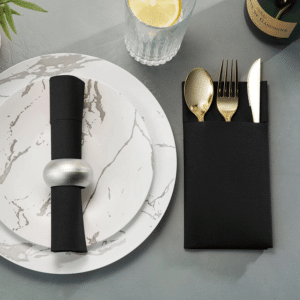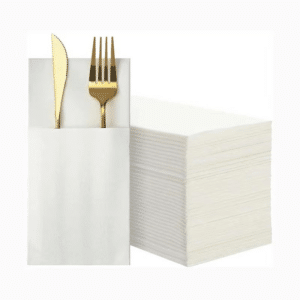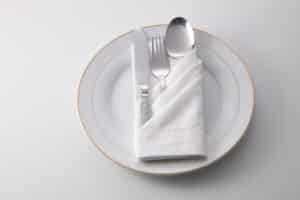When deciding between airlaid napkins and linen napkins for a cafeteria, several factors come into play, including cost, appearance, feel, maintenance, and environmental impact.

Airlaid Napkins
Material and Feel:
- Airlaid napkins are made from a nonwoven fabric, created by air laying cellulose fibers.
- They have a cloth-like texture and are softer and more absorbent than standard paper napkins.
- They provide a more luxurious feel compared to typical paper napkins.
Cost:
- Generally more expensive than regular paper napkins but cheaper than linen napkins.
- No recurring costs for laundering.
Maintenance:
- Disposable, so no need for washing or ironing.
- Convenient for busy environments as they can simply be disposed of after use
Appearance:
- They often look and feel similar to fabric napkins, making them suitable for settings where a more upscale appearance is desired.
- Available in various colors and patterns.

Environmental Impact:
- Single-use, contributing to waste.
- Some airlaid napkins are biodegradable, but their environmental impact is still higher compared to reusable options.
Linen Napkins
Material and Feel:
- Made from fabric, typically linen or a cotton blend, providing a soft and elegant feel.
- They have a higher-end, classic look and feel.
Cost:
- Higher initial investment compared to airlaid napkins.
- Ongoing costs for laundering and possibly replacement over time.
Maintenance:
- Requires regular washing, drying, and ironing.
- Labor-intensive compared to disposable options.
Appearance:

- Superior in terms of elegance and presentation.
- Typically associated with finer dining experiences.
Environmental Impact:
- Reusable, reducing waste.
- Environmental impact depends on laundry practices (water and energy use, detergents, etc.).
Considerations for a Cafeteria
Usage Volume
- High turnover in cafeterias might make airlaid napkins more practical due to their disposability.
- Linen napkins might be more suitable for special occasions or sections of the cafeteria with lower turnover.
Cost of Use
- Assess the balance between initial investment and ongoing costs.
- Airlaid napkins might be more cost-effective for high-volume, daily use
Customer Experience
- Airlaid napkins offer an upscale touch without the maintenance of linen.
- Linen napkins provide a premium dining experience but require more upkeep.
Environmentally Friendly
- If sustainability is a priority, consider the trade-offs between single-use disposables and the resources required for laundering linens.
Conclusion
For most cafeterias, airlaid napkins strike a balance between cost, convenience, and appearance, offering a more refined feel than standard paper napkins without the maintenance demands of linen. However, if your cafeteria aims to provide a more upscale dining experience and can manage the maintenance, linen napkins could be an excellent choice.
